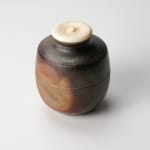Yamamoto Izuru 山本出
H8.3 × Dia 6.4 cm
Further images
-
(View a larger image of thumbnail 1
)

-
(View a larger image of thumbnail 2
)

-
(View a larger image of thumbnail 3
)

-
(View a larger image of thumbnail 4
)

-
(View a larger image of thumbnail 5
)

-
(View a larger image of thumbnail 6
)

-
(View a larger image of thumbnail 7
)

-
(View a larger image of thumbnail 8
)

-
(View a larger image of thumbnail 9
)

Born into a family of potters, Yamamoto Izuru (b. 1944) brings a sculptor’s perspective to Bizen pottery. He studied under his father, Living National Treasure Toshu Yamamoto, for five years before establishing himself as an independent artist. Throughout his practice, he has embraced both tradition and innovation, developing two original techniques—‘Shusai’ and ‘Tatakikomi’—in which he layers and pats colored clay onto the surface of his works. His experimentation continued after discovering the distinct composition of clay in Bourgogne, France, leading him to develop a third technique, “Tsumiage,” a method of stacking plated clay in slate-like formations. A graduate of Musashino Art University with a major in sculpture, Yamamoto’s approach is deeply shaped by 20th-century sculptural influences, lending his work a striking sense of structure and materiality.
This tea caddy is deceptively simple: a thin incised line runs around the circumference of its cylindrical torso, adding a contemporary flair to the exploration of a traditional, austere form. The tea caddy reflects a more traditional side of Yamamoto's practice








